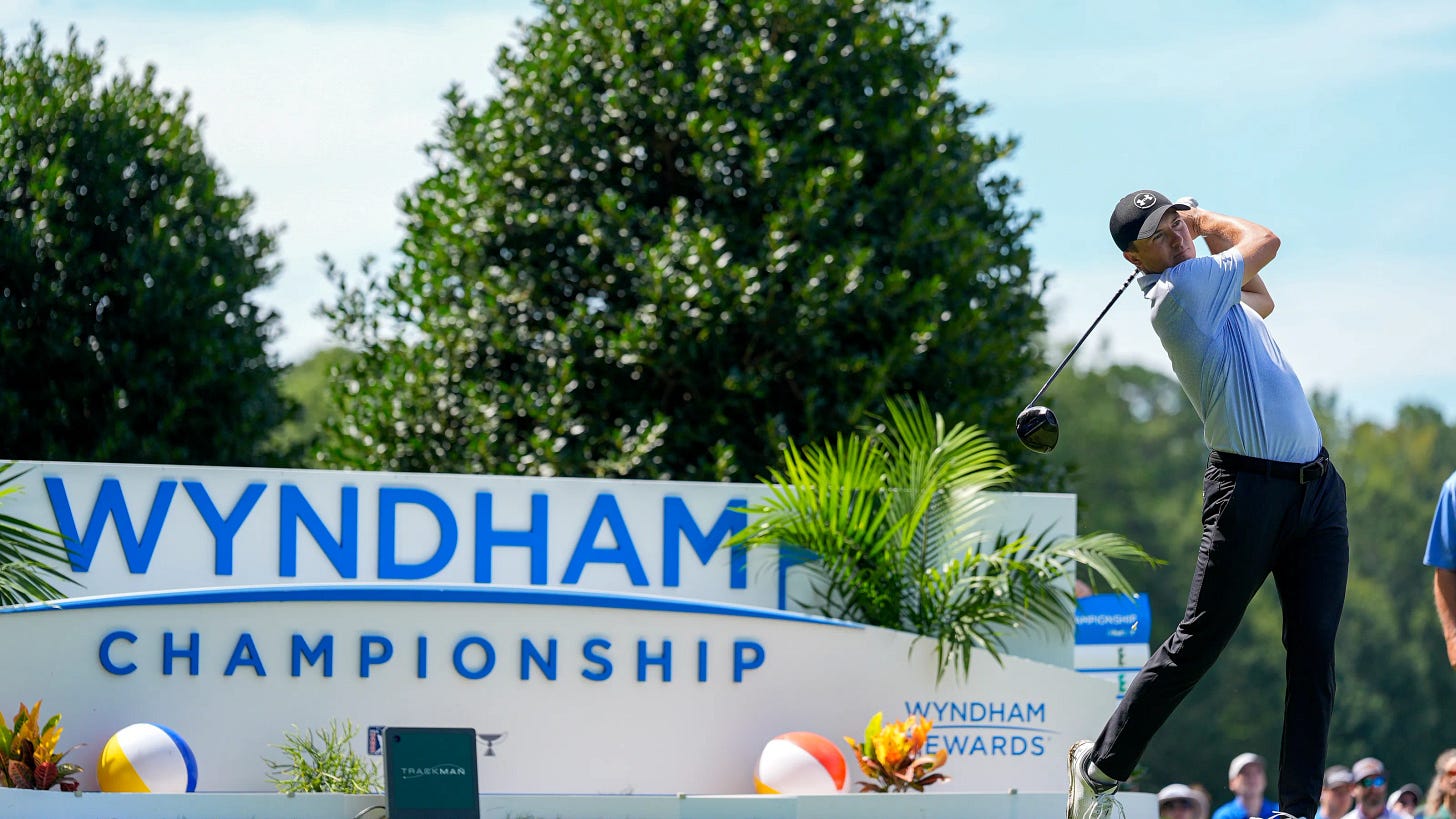📍 Sedgefield Country Club – Course Details
📌 The Setup
Location: Greensboro, North Carolina
Architectural Roots: Designed by Donald Ross in 1926; restored in 2007 by Kris Spence
Event Host: Permanent home of the Wyndham Championship since 2008
📐 Course Specs
Par: 70
Yardage: ~7,127 yards
Course Rating / Slope: 75.3 / 143
🧬 Design DNA
Fairways: Tree-lined and tight — average width around 29–30 yards
Greens: Champion Bermuda; firm, fast, and subtly contoured
Rough / Surrounds: Bermuda rough with run-offs and collection areas
Bunkers & Water: Over 50 bunkers and water hazards on six holes
As I write this, Kurt Kitayama is making a strong push in Minnesota with just three holes to play. Barring a big late surge from Sam Stevens or Jake Knapp, it looks like Kitayama will take it — a real win for data, as we were able to identify a great ball-striker primed to spike on relatively basic green complexes.
Next week, the tour heads to Greensboro, North Carolina, for one of my sneaky favorite events of the year: the Wyndham Championship at Sedgefield Country Club. What a contrast this course is to TPC Twin Cities. According to DataGolf, Sedgefield is one of the most predictive courses on tour, year in and year out. What does that mean? It means players with a very specific skill set tend to consistently succeed here. And when someone finds success at Sedgefield, they tend to repeat it.
You might as well call it Webb Simpson Country Club. In 16 starts here, Webb has racked up seven top-5 finishes — plus several more top 10s and top 20s. Fittingly, he even named his daughter Wyndham (not a joke).
Unlike TPC Twin Cities, where water serves as the primary defense, Sedgefield challenges players with firm, undulating greens and narrow fairways that penalize missed tee shots. We’ll look to identify the skill sets — and the players — best suited to thrive in Greensboro.
I love this golf course.
TPC Twin Cities should serve as an important reminder to golf fans about what truly challenges the modern professional. Simply adding length doesn’t equate to difficulty. Without wind — and with soft, flat greens — it becomes target practice. At TPC Twin Cities, the only real hazard that forces players to think is the presence of water, which introduces risk and brings big numbers into play.
That’s not the case at Sedgefield.
Yes, it’s typically won with a score between 15 and 20 under, but the nature of the challenge is entirely different. This course cannot be “bombed and gouged.” The Bermuda rough at Sedgefield plays nothing like Kentucky bluegrass. Out of the rough, distance control becomes extremely difficult, and there’s virtually no chance to generate spin. To score here, you have to play from the fairway.
The recipe for success is well-defined and has held firm over the years:
Accuracy off the tee > Distance
Elite iron play
Bermuda grass short game & bunker play
Confidence with the putter on Bermuda greens
This course rewards a specific type of player — and it’s reflected in the leaderboards: Webb Simpson, Russell Henley, Billy Horschel, Jim Furyk, Kevin Na — all textbook fits.
There’s also a clear crossover with other positional tracks. TPC Sawgrass shares a striking overlap in winners and skill sets. Harbour Town is another close comp — a shorter course that demands accuracy, touch, and strategy over power.
To build out a model for this week, we’re taking a mixed-conditions approach tailored to what historically works at Sedgefield — and what correlates across similar tracks. We’re focusing on:
Driving performance on less-than-driver courses, with an emphasis on accuracy over distance
Overall approach play, highlighting wedge and mid-iron proximity
Short game performance, especially around the green on grainy Bermuda grass
Bermuda putting, with a lean toward those who putt well in the Southeast
Course history and performance on comparable layouts:
TPC Sawgrass
Harbour Town
Copperhead (Innisbrook)
All three comps demand similar skill sets — precision off the tee, control on approach, strong scrambling, and comfort on Bermuda greens.
Let’s see who rises to the top when we plug in these conditions.
🔥 Hideki Matsuyama
I absolutely love this spot for Hideki. The driver has been the one weak link in his game this year, and Sedgefield gives him plenty of chances to club down — a major win for his profile. Everything else has been strong. Most notably, in what feels almost un-Hideki-like, the putter has been great. He’s gained strokes putting in 9 of his last 10 starts. That’s a scary combination when paired with his iron play and touch around the greens. Don’t be surprised if he wins this week.
👀 Ben Griffin
This is the type of course Ben Griffin should thrive on. If he hadn’t already made such a strong impression this season, I’d be calling this a breakout spot for him. The concern: he’s played a ton of golf in 2025, and the signs of regression are starting to show. That said, the course fit is undeniable.
🧠 Other Names to Circle
Si Woo Kim – Former winner, elite on Bermuda, fits the comp course mold
Lucas Glover – Always dangerous when he’s dialed with irons
Matt Fitzpatrick – Positional golf specialist; thrives on short, strategic layouts
Aaron Rai – One of the best drivers of the golf ball on tight courses
Eric Cole – Short game wizard with growing consistency
Bud Cauley – Trending nicely, and this would be a storybook return
Denny McCarthy – Arguably the best Bermuda putter in the field
JT Poston – Former champ with strong crossover form
Davis Thompson – Big upside, gaining steam at the right time
Luke Clanton – The young gun’s ceiling is high, and he’s fearless
I’ll be back later this week with a more refined model and potential outright targets. Stay tuned!


